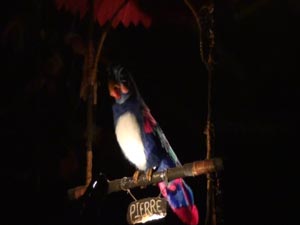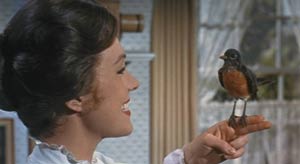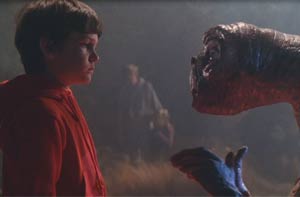Famous Animatronics
Famous animatronic figures offer memorable entertaining experiences for audiences at various amusement parks and restaurants. Figures have also been featured in movies since the 1960's. Some of the imaginative animatronics are easy to recognize, but some figures are so lifelike, it may surprise you that they are not real. These are some of the most well know animatronics, created to entertain audiences.
![]()
1. Enchanted Tiki Birds (1963 Disneyland and Walt Disney World)
 The first audio animatronic figures ever seen by an audience were in the Enchanted Tiki Bird show at Disneyland. The attraction opened in 1963. Nearly everyone in the U.S. has seen these birds or at least heard them singing the Tiki room song. The popular show was also added to Tokyo Disneyland.
The first audio animatronic figures ever seen by an audience were in the Enchanted Tiki Bird show at Disneyland. The attraction opened in 1963. Nearly everyone in the U.S. has seen these birds or at least heard them singing the Tiki room song. The popular show was also added to Tokyo Disneyland.
The Tiki birds were probably the first produced by Disney because they are fairly simple, by today's standards. But in 1963 the technology was all new. The WED Enterprises group had to create the lifelike figures, a control system, programming, and syncing to sound all from scratch.
2. Abraham Lincoln (1964 New York's World Fair - 1965 Disneyland)
The Abraham Lincoln figure developed by Walt Disney and his team of imagineers deserves a special place among animatronics because it was the first human figure. The figure was first featured at the 1964 New York World Fair. It was later featured at Disneyland, California in 1965 in the attraction Great Moments with Mr. Lincoln.
3. Jaws (1975 Theatrical Movie)
The killer great white shark filmed in the movie was an animatronic shark. Actually, three animatronic sharks were built for Stephen Speilberg's breakout movie. Anyone who grew up in the 1970's and 1980's had the thought of the frightening shark when swimming in the ocean. For those who visited Universal Studios in California in the late 1970s, a version of the animatronic shark could be seen in a small lake along the tram route.
4.  Animatronic Birds (1964 Mary Poppins Theatrical Movie)
Animatronic Birds (1964 Mary Poppins Theatrical Movie)
Another first in anamatronics was the use of a figure in the 1964 film, Mary Poppins. Walt Disney had his special team of "imagineers" in WED enterprises create the animatronic robin that sings along with Julie Andrews in the song "A spoonful of sugar". Disney fans and fans of the Mary Poppins film still remember this surprising technology addition to the film (at the time of release). Watching the film now, viewers can see how ahead of his time Walt was with this film.
5. E.T. (1982 Theatrical Movie)
Steven Spielberg again used an animatronic character as the main character in a movie. The E.T. figure, which was designed by Carlo Rambaldi, pushed animatronics in filmmaking. E.T. was capable of 150 different movements, including many different facial expressions, neck, hand, and of course, finger movements. The detail of this figure was needed to develop the personality of the character in the film.
6. Jabba the Hut (Star Wars: Return of the Jedi Theatrical Movie)
Creation of the huge Jabba the Hut character on-screen required building an animatronic figure to fulfill George Lucas' vision. The scene in which Princess Lea ultimately choked Jabba to death is well remembered among Star Wars fans. To pull off the movements there was a delicate balance between communication between animatronic operators, on screen actors, and the filmmaker.
7. Chuck E Cheese (1977 Restaurant)
The Chuck E Cheese animatronic mouse has entertained kids since 1977. Nolan Bushnell, also the found of Atari, originally started the Chuck E Cheese restaurant concept using an animatronic mouse as one of the ways to entertain guests. Obviously, video games were also a large part of the experience at Chuck E Cheese restaurants. The design of the Chuck E Cheese animatronic figure varies at different locations. Many restaurants feature an oversized Chuck with a full band playing timed shows with music and lighting. Although, the characters are not very life-like, they were deliberately designed large so guest further away from the stage could see the show. At one time obtaining a table was extremely difficult, since animatronics were only on display at Disney parks and a handful of other amusement parks. Chuck E Cheese is still performing for audiences today, after more than 35 years.
8. Free Willy (1993 Theatrical Movie)
Free Willy, like Jaws, used an animatronic character as the main character in a water setting. Unlike Jaws, Willy the Orca Whale was built with great details to match the exact appearance of a real orca whale also used for the film. Since Orca whales can be trained, a real whale was used for many scenes, but the animatronic whale was used to avoid scenes that may have been considered harmful to the real animal. In later Free Willy movies, the animatornic whale was used much more prevalently. The 6400 pound animatronic whale was designed and built by Walt Conti and his team.
9. Pirates of the Caribbean (Attraction 1963 Disneyland, 1973 Walt Disney World)
The classic pirate boat ride adventure, which included design ideas from Walt Disney himself, is still an icon today. The ride has since been upgraded with some more modern animatronic characters, based on the Pirates of the Caribbean movie series. Not only is the attraction featured in Disneyland and the Magic Kingdom, but it has been so popular that Disneyland Paris and Tokyo Disneyland also now feature the ride. Even though specific animatronics have been upgraded in the ride, one of the most remembered animatronincs scene is the two pirates trying to coax the jail cell keys from a loveable dog.
10. Jurassic Park (1993 Theatrical Movie)
Steven Speilberg once again used the ultimate 3D models for one of his films, animatronics. In this movie, Stan Winston Studios created the animatronic dinosaurs used to make the film appear life-like. Computer graphics would not have the same effect on the scenes as the robotic dinosaurs. Ultimately the effects had the results that Speilberg and his investors were looking for, an Academy award for visual effects and over $350 million in box office ticket sales in the U.S. alone.
